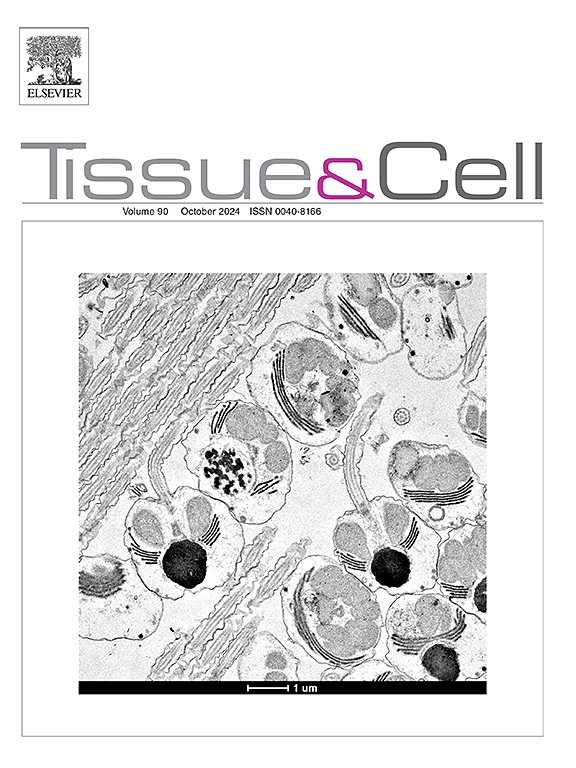Periostin enhances paracrine effect of adipose-derived stem cells on chondrocyte proliferation, adhesion and migration
IF 2.7
4区 生物学
Q1 ANATOMY & MORPHOLOGY
引用次数: 0
Abstract
Background
Articular cartilage regeneration after injury remains a difficult clinical problem. Studies have revealed that adipose-derived stem cells (ADSCs) can promote chondrocyte regeneration. This study explored the role of Periostin, a multifunctional extracellular matrix protein, in enhancing the paracrine-mediated effects of ADSCs to promote chondrocyte regeneration.
Material and methods
ADSCs were isolated from murine adipose tissue and characterized. Periostin was overexpressed via a lentiviral vector in ADSCs (P-ADSCs). Chondrocytes were isolated and cocultured with P-ADSCs, followed by assessing of cell viability, apoptosis, cell migration and adhesion. In addition, periostin concentrations in the co-culture medium were measured over time by ELISA and detailed densitometric analyses of signaling proteins were performed.
Results
Compared with control ADSCs, P-ADSCs significantly enhanced chondrocyte proliferation, reduced apoptosis, and promoted migration and adhesion. ELISA quantification revealed that chondrocytes co-cultured with P-ADSCs showed a significant decrease in pro-inflammatory cytokines of IL-1β, IL-6, IL-18 with less than 0.6 fold-changes, and a significant increase in growth factors of TGF-β, b-FGF, PDGF with more than 4 fold-changes. Moreover, qPCR and immunoblotting demonstrated upregulation of key chondrocyte markers collagen II and Sox9, and activation of FAK/PI3K/Akt/ERK signals.
Conclusions
Periostin overexpression in ADSCs enhances their paracrine effect, promoting chondrocyte proliferation, adhesion, migration, and favorable phenotypic marker expression while modulating cytokine secretion. These findings provide a potential strategy for enhancing ADSC-mediated cartilage repair.
骨膜蛋白增强脂肪干细胞对软骨细胞增殖、粘附和迁移的旁分泌作用
背景:关节软骨损伤后的再生仍然是一个临床难题。研究表明,脂肪来源的干细胞(ADSCs)可以促进软骨细胞再生。本研究探讨了多功能细胞外基质蛋白Periostin在增强旁分泌介导的ADSCs促进软骨细胞再生中的作用。材料和方法从小鼠脂肪组织中分离出sadscs并进行表征。通过慢病毒载体在ADSCs (P-ADSCs)中过表达Periostin。分离软骨细胞并与P-ADSCs共培养,然后评估细胞活力、凋亡、细胞迁移和粘附。此外,通过ELISA测定了共培养培养基中随时间变化的骨膜素浓度,并对信号蛋白进行了详细的密度分析。结果与对照ADSCs相比,P-ADSCs能显著增强软骨细胞增殖,减少细胞凋亡,促进细胞迁移和粘附。ELISA定量结果显示,与P-ADSCs共培养的软骨细胞IL-1β、IL-6、IL-18促炎因子显著降低,变化幅度小于0.6倍,TGF-β、b-FGF、PDGF生长因子显著升高,变化幅度大于4倍。此外,qPCR和免疫印迹显示,关键软骨细胞标志物胶原II和Sox9上调,FAK/PI3K/Akt/ERK信号激活。结论在ADSCs中过表达speriostin可增强其旁分泌作用,促进软骨细胞增殖、粘附、迁移,调节细胞因子分泌,促进有利表型标记的表达。这些发现为增强adsc介导的软骨修复提供了一种潜在的策略。
本文章由计算机程序翻译,如有差异,请以英文原文为准。
求助全文
约1分钟内获得全文
求助全文
来源期刊

Tissue & cell
医学-解剖学与形态学
CiteScore
3.90
自引率
0.00%
发文量
234
期刊介绍:
Tissue and Cell is devoted to original research on the organization of cells, subcellular and extracellular components at all levels, including the grouping and interrelations of cells in tissues and organs. The journal encourages submission of ultrastructural studies that provide novel insights into structure, function and physiology of cells and tissues, in health and disease. Bioengineering and stem cells studies focused on the description of morphological and/or histological data are also welcomed.
Studies investigating the effect of compounds and/or substances on structure of cells and tissues are generally outside the scope of this journal. For consideration, studies should contain a clear rationale on the use of (a) given substance(s), have a compelling morphological and structural focus and present novel incremental findings from previous literature.
 求助内容:
求助内容: 应助结果提醒方式:
应助结果提醒方式:


